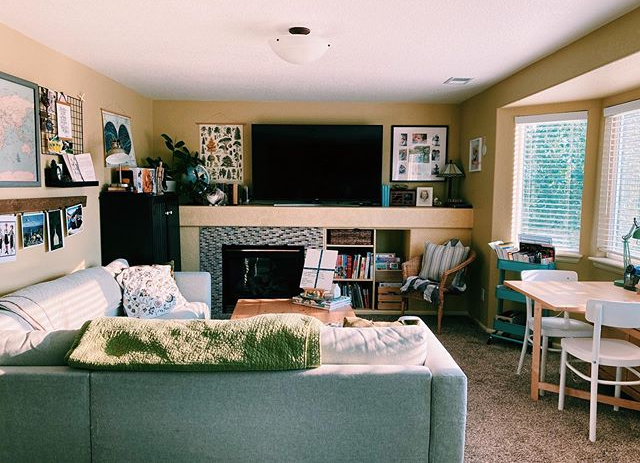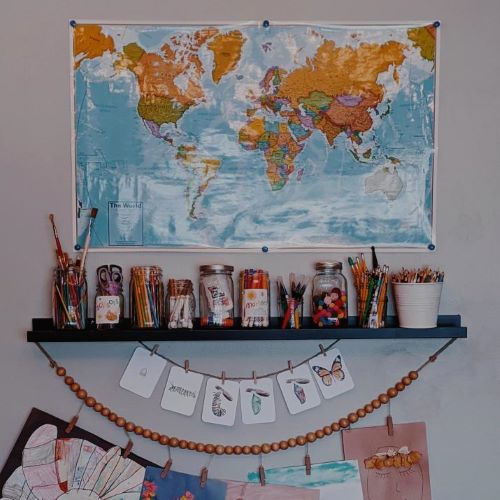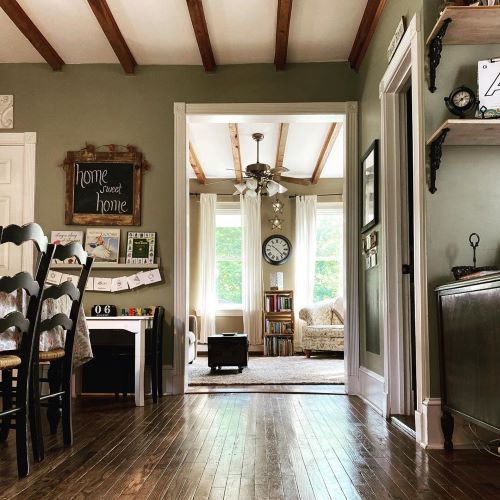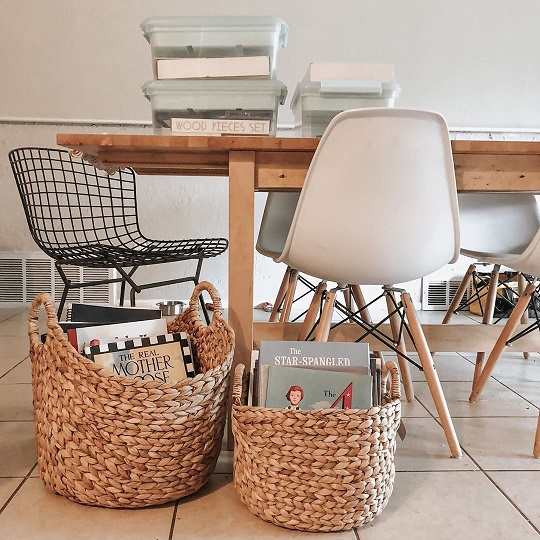Cultivating a space that breathes life into learning can make all the difference to our homeschool experience. We long for a space that is orderly yet inviting, cozy yet primed for creative exploration. But living within our limitations to make the most of the spaces we have can be a challenge!
That’s why we’ve invited these six homeschool moms to share how they’ve come to embrace the space they have and make it work for their families. In each of their stories, you’ll hear the tension between the ideal picture of what a homeschool space “should” look like and the very real needs of their families. Whether you’re limited by a small house, financial restraints, messy kids, or a lack of dedicated homeschool space, I know you’ll draw inspiration and encouragement from these wise mamas.
From Rebecca at A Humble Place:

When we first moved into this house, I fully intended to use part of the basement for our homeschool area. We set up a table and got cubby shelves and put maps on the walls and I had my little Raskog cart ready to go for the first day of school. It ended up working really well that year as all of our toys were down there as well, and my two-year-old daughter was able to play during our 45-minute “school time.” I planned to get more for the area – a space heater and maybe a TV for YouTube nature study and composer study videos, but I thought that was the best place for us. I was actually a little obsessed with having a specific area of the house only for homeschool.
⠀⠀⠀⠀⠀⠀⠀⠀⠀
Fast forward to the next year and events happened where I decided to move everything – table, maps, and all – up to our family room. It was only going to be temporary, but….well…..how convenient, there was a TV already there! And look at that! A gas fireplace! And, hey, more windows and a nice view! And so we stayed. Instead of investing in a separate area, we were able to buy a few things for this area, like a big couch and coffee table, that not only made our family room cozier but also made our learning environment a nice place to be. I decided I really wanted to embrace the “home” part of homeschooling for our environment.
Rebecca lives in Colorado with her husband and two children and has been home educating since 2016. She enjoys the freedom found in homeschooling and the fact that it not only nourishes the minds, hearts, and souls of her children, but hers as well. You can follow Rebecca on Instagram at @ahumbleplace.
From Heather at Unrelenting Grace:

This is real life, friends. The books are hardly ever straightened. Broken crayons cover the floor, pencil shavings are on the table. Barely used paper lies crumbled everywhere. My eyes can’t unsee the mess. And yet the kids don’t seem to see a thing.
Looking at beautiful pictures of homeschool spaces is one of my favorite things to do on Instagram. I love to see how other people design and decorate their space. But I sometimes have to remind myself that we typically only share the pretty things here, don’t we? The picture before the day started; not the “after the storm” photo.
Here’s your reminder that no matter what your space looks like, no matter the size, no matter the style, or the lack of inspiration….it’s yours! Do what you can to make it an enjoyable learning space for your children and leave the comparison at the front door.
Designated homeschool rooms aren’t necessary. They’re nice to have, sure. But learning takes place everywhere. Utilize nature. Front porches, walking trails, lakeside views, or parks. Gather around dining room tables, comfy couches, Mama’s bed, or living room floors.
Just make the most of your time together in the place God has called you to.
Heather is a pastor’s wife and homeschooling Mama of 5, and southern to the core! Just a small town country girl with a passion for home education. Her family is embarking on their 8 year of schooling at home, realizing that learning never stops and good books are a must. You can connect with Heather on Instagram at @un_relentinggrace.
From Georgia at Wildflower Warriors:

This room was designed to be a dining room, and has been everything but that for our family! Before a school room it was our crafting space, so it made the transition smoothly.
For the most part everything has been a hand-me-down, gently used, or something I built myself with a few exceptions. When we decided to homeschool we moved the girls desks into this space. Then, I went around to each room in the house asking, “Does anything in here belong in our school room?” And it’s become what it is.
It’s packed in, but gives us everything we need. A wannabe nook for reading by the window (a gym mat folded with a blanket on top), a nature table full of loose parts to play with, our sensory bin, an art cart, desks etc.
Honestly, I’m a minimalist at heart, but I’ve given this room permission to be what it is. And although we have a designated area, I believe learning can happen anywhere. This space is a work in progress and will continue to be so for as long as we’re occupying it for learning. As we learn, we grow and evolve, and the room will too.
Georgia believes educating her children is a great honor and brave responsibility. When it comes to learning, it can happen anywhere—allowing the outdoors to be their main “classroom.” These nature lovers and life learners approach education in an eclectic way, with a heavy focus on nature, play, and quiet times spent together You can follow Georgia on Instagram at @wildflower.warriors!
From Jess at Raising Oaks & Arrows:

You know the old adage, “Out of sight, out of mind?” In my years of parenting, I’ve discovered this is certainly true with arts and craft supplies.
⠀
When the supplies are kept up-high or locked away in a cabinet to avoid a mess, very little free creativity happens.
⠀
I never want my children’s creativity to be based on my availability. In other words, if they are inspired to draw a butterfly, but I’m rocking a baby to sleep, I don’t want them to not be able to create because my hands are busy and I can’t go dig out the supplies.
⠀
If you’ve wanted to have an open-ended art space in your home but aren’t sure where to begin, here are a few things I’ve learned through trial and error that I hope might help.
- Designate a space in your home for creating. Expect that it will get messy, so provide a surface that you’re ok with getting messy.
- Keep a wide variety of age appropriate art supplies within reach of the children.
- Provide a designated are to display their art once it’s finished. I personally love their art, but loath the cluttered look of it taped to every vertical surface in our home.
- Start young. If the items are available for exploration and use for as long as the child can remember, they are less likely to misuse them. Just like a child comes to learn that shoes come off when we enter the house, they come to learn that glue and markers are to be used at the craft table.
- Provide organized supplies, but don’t feel like it needs to be fancy. Gather old Mason or spaghetti jars and fill them the pencils, markers, googly eyes, scissors, rulers, hole punches, glue, pom-poms, pipe cleaners, colored pencils or whatever else you have laying around!
- If possible, locate your art area in a central portion of the home. If it’s tucked in the back corner of the basement, it’s not likely to be used.
My last tip is to just go for it! Don’t wait till they are older or you have more room, just lay out some paper and supplies and let their little minds run wild.
Jess is a second generation homeschool mama of three littles, in the process of adding a fourth little to their crew through international adoption. She is passionate about raising her children to know and love the Lord, and to view education as a lifestyle. You can connect with Jess at @raisingoaksandarrows where she shares bits of her homeschooling journey, as well as her love of homemaking, motherhood, thrifting, and occasionally, her chickens.
From Kristin at With Quiet Hands:

Learning is not limited by space. You can, and do, learn anywhere. Take advantage of this, homeschoolers: do not bind your kids, or yourself, to a desk.
You can have a homeschool space, but you don’t need one. Our homeschool table was a tiny kids table in our dining room. We used it as a landing spot, but only a small fraction of learning happened there.
We took school outside often, reading books on a blanket under a tree, or creating art on the deck. We learned in the kitchen as we prepared food. We learned by our living room window where we watched the birds come to our feeder. We learned during car rides as we listened to audiobooks and discussed matters together. We learned in the yard during hours of play. We learned at the dining room table during our morning time. We learned in bed snuggled up reading stories at night.
We learned under canopies of trees, beside the roaring sea, with ankles deep in fresh water, between rows of fruit trees, engulfed in fields, glowing by the light of the campfire. Nature is the ultimate classroom. There, learning is authentic, meaningful, life-giving.
Opportunities to learn are everywhere. That’s why I’m only mildly nervous about starting the school year with a big move. The week I would have thought I’d be beginning kindergarten with my son and pre-K with my daughter, we will be uprooting and replanting and beginning a new life. There is no homeschool room, no formal lesson plans, at least not for a while.
But we will still be learning, and likely learning a lot. Education is not synonymous with school. Education, as Charlotte Mason says, is a life.
So go ahead, ditch the desk. When you do, you live out the belief that learning is a lifestyle. Education is all around you, if you have eyes to see it.
A high-school teacher turned homeschool mom, Kristin is passionate about education and lifelong learning. She adores teaching her two littles in the Charlotte Mason style and desires to empower other parents in their homeschooling pursuits. You can connect with Kristin on Instagram at @withquiethands.
From Bobbye at Bobbye West:

How do I organize our home school in a small space? It’s possible!
Each week we use a variety of picture books. These are kept in the smaller of the two baskets you see on the floor. The larger of the two baskets hold materials that are in constant use – things like the early reading book I made, handwriting books, our Kate Snow math book, alphabet books, nursery rhymes, poetry books, and bible story book we read from daily.
Both of these baskets are always stored under our vintage card catalogue. It’s right by my table so it’s easy to grab for lessons.
I have a snap lid containers for content areas. One is for reading/letter sounds. I keep alphabet flash cards, the games from our Pre-K primer, and our Delightful Reading Kit in this box. Another is for handwriting. All of our Handwriting Without Tears materials are in this box. The last box contains all our materials for nature journaling and our nature journals. The cardboard box on top is our Kindergarten Tool Kit. We use cards from this daily and the box it shipped in is so sturdy I’ve just kept using it to store our cards!
These snap lid boxes are stacked right behind my desk and next to our printer. The printer sets on a little cabinet I got at a garage sale which holds our art supplies.
I also keep one plastic pin that holds small manipulatives we use for math and whatever printables we’ll be using in the next few weeks.
I do NOT keep all our printables and books out. It would just be cluttered and chaotic. I organize books by subject and store them in bins so I grab what I need. I organize printables in a plastic file box and also grab what I need.
We are currently beginning to remodel our 1950s house as is evidenced by the drill you see on the ground in the lower right hand corner of this pic. I’m so excited to get started and have plans to build in some shelving and display areas into our sunroom so that it’s a more dedicated homeschool space. For now though, this works for us and I’m certain it can work for anyone in a smaller space that’s homeschooling.
Bobbye lives in North Texas with her husband, 6 year old daughter, and two adventurous dogs. She believes her family is her first ministry and pours her heart into her mothering and her marriage. Her homeschool is inspired by the writings of Charlotte Mason; you’ll find her family in the middle of a National Forest almost as often as you’ll find them at home. Wherever her school is located, a peaceful rhythm can be found and probably also a good cake at teatime. You can find Bobbye on Instagram at @bobbyewest_.
Enjoy this post? Read on, and sign up for our homeschool newsletter!
Discovering Your Homeschool Style Quiz